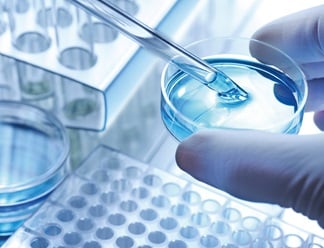HARTMANN SCIENCE CENTER

Transmission of pathogens to humans occurs via a wide variety of routes. The main transmission routes of many clinically relevant pathogens are concentrated in four modes of transmission1.

When an infected person sneezes, coughs or talks, droplets and/or aerosols containing the pathogen may be produced. These can subsequently be inhaled by other persons and get onto the mucous membranes of the respiratory tract or the mucous membranes of the eyes. This can result in pathogen transmission. In simplified terms, a distinction is made between larger droplets (> 5 µm) and small aerosols (< 5 µm) on the basis of particle size and their physical properties. Droplets sink quickly in the air due to their gravity and can therefore only be transmitted over close distances (< approx. 1.5 m). Examples of diseases and pathogens that are mainly transmitted via droplets are influenza, adenovirus and rhinovirus.
Small aerosols, on the other hand, can remain suspended in the air for a long period of time. They can spread in the air of closed rooms or over long distances (> 1.5 m). Aerogenic transmission occurs, for example, in overt pulmonary tuberculosis, which is caused by Mycobacterium tuberculosis. Other examples are measles and varicella.
Since the transition between droplets and aerosols is fluid, mixed forms with droplet transmission as well as aerosol transmission can also exist, as is the case, for example, with SARS-CoV-2, the causative agent of COVID-19 disease.
Currently, the scientific community is debating whether the classical terms of droplet and aerogenic transmission, which are well known in hygiene, should be replaced by near-distance and far-distance transmission2.
The pathogens are transmitted directly or indirectly, mainly via the hands. In direct contact, the pathogens are transmitted between an infected person or animal and a non-infected person via direct physical contact (e.g. shaking hands). Herpes simplex viruses (HSV), the causative agents of labial and genital herpes, can be transmitted this way.
Indirect contact infection, on the other hand, occurs between an uninfected person and their environment. This can be, for example, contaminated objects or inanimate surfaces. The pathogens then subsequently enter the body of the non-infected person, for example via open wounds or the mucous membranes. One form of indirect contact infection is smear infection. It occurs fecal-orally via the excretions of infected persons. Noroviruses, which cause severe diarrheal diseases, are an example of this transmission route.
The transmission of pathogens via blood or tissue is also referred to as parenteral transmission. This can occur, for example, via needlestick injuries. Hepatitis B is transmitted in this way. However, pathogens can also be transmitted via bodily secretions such as saliva, sweat, pus or semen. HIV, for example, is transmitted during sexual contact.
Transmission through contaminated water or food can be counted as an indirect contact infection. This type of infection often occurs in areas with poor hygiene conditions. Bacteria that have entered the drinking water through excretions or are found on animal products are often transmitted. Salmonella typhi, the causative agent of typhoid fever, is transmitted in this way. Another example is the bacterium Vibrio cholerae, which causes cholera.
In addition to the four main modes of transmission, vector-associated transmission is also possible. Vectors are living organisms. For example, transmission can occur through the bite or sting of bloodsucking insects. Starting from an infected host animal, the pathogen is passed on to humans via a transmitter (vector) and thus enters the bloodstream. One example of this is the plague. The bacterium Yersinia pestis is transmitted from rats to humans via infected fleas.
References:
1 KRINKO (2015) Infektionsprävention im Rahmen der Pflege und Behandlung von Patienten mit übertragbaren Krankheiten. Bundesgesundheitsbl 58:1151–1170.
2 Pöhlker et al. (2021) Respiratory aerosols and droplets in the transmission of infectious diseases. arXiv:2103.01188 [physics.med-ph].